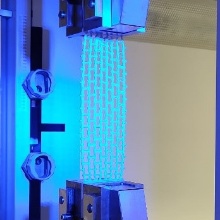In the world of advanced materials, auxetic structures stand as a fascinating and innovative domain. These structures possess a unique property of negative transverse contraction, making them exceptionally promising in various applications. Our work at the institute is dedicated to exploring the material response of hyperelastic auxetic materials, where this distinctive behavior is prominently observed.
Auxetic geometries, exemplified by structures with a negative transverse contraction number, represent a significant area of interest. Figure 1 provides a visual representation of various planar auxetic structures.
Experimentally, we fabricate these intricate auxetic structures using 3D printing and subject them to tensile tests to gain insight into their strain field under varying load conditions. For this purpose, we employ a cutting-edge technique called digital image correlation (DIC), utilizing a 2D non-contact optical measurement system (ARAMIS, GOM, Germany) to measure in-plane displacement and determine strain fields on the specimen's surface during the tensile test.
To enhance measurement accuracy, we strategically apply black paint to create random yet distinct speckles on the sample surfaces. In the post-processing phase of deformed samples, we define a measuring zone within the relevant area of the tested sample to calculate averaged strains.
To advance our investigation, we must focus on the following key themes:
- Understanding hyperelasticity within auxetic materials.
- Developing mathematical models to replicate the behavior of these innovative structures.
- Examining various constitutive laws for auxetic materials, particularly in the context of high-tech applications.
- Addressing the challenges of verification and validation of simulation results.
- Investigating the discrepancy between simulation outcomes and real physical behavior of auxetic structures.
Nowadays, many mathematical models are available to reproduce the real behaviour of new materials such as polymers. Several constitutive laws for polymers are of great interest to the aircraft industry. In recent years, the need for verification and validation of simulation results gained importance. Nevertheless, the discrepancy between simulation results and real physical behaviour is still observed in many cases. Computers and especially the computational Finite Element Method (FEM) were a great revolution that improved not only the study of polymer mechanics, but also the analysis of components in general. Closed-form calculations using a simple material model, such as linear elasticity, are computationally efficient, but cannot be applied to complex geometries. Finite Element (FE) simulation using an advanced material model captures nonlinear geometric effects and can accurately capture the material response. However, these analysis techniques make material model calibration more difficult than FE simulation using a simple material model, and increase the computational cost.
Experimental Mechanics:
Optimizing Energy Absorption of 3D-Printed Auxetic Cylindrical Structures
Analysis of the linear and nonlinear buckling behavior in auxetic structures
Simulation and Optimization of Auxetic Metamaterials under Quasi-Static Loading Conditions
[MASTER] Generative Networks for Designing Auxetic Materials Maximizing Poisson Ratio

Berta Pi Savall
M.Sc.Research Assistant, Diversity Officer of Faculty 6





